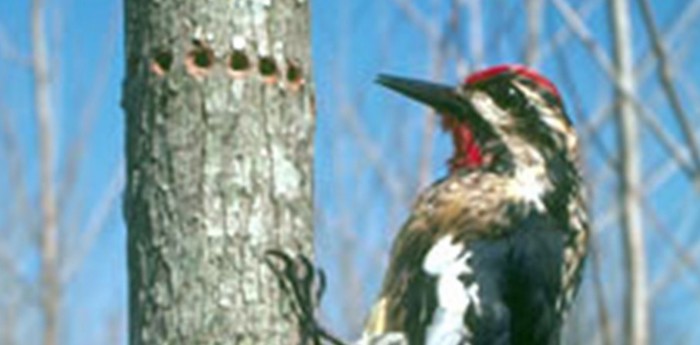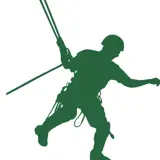
Woodpecker Damage

A woodpecker drilling holes to feed on sap and the insects attracted to it. Photo by James Soloman, USDA Forest Service.

Published June 1, 2009, By ARBORILOGICAL SERVICES
Arborists are often asked, “What is boring holes in a straight line across my tree’s trunk?” The woodpecker is the culprit, and most of the time it causes no health problems for the tree. The most common woodpecker in our area is the Yellow-Bellied Sapsucker. This migratory bird can be identified by its medium size and distinctive markings. The adult birds are identified by a black crescent on the breast, pale yellow belly, white wing stripe, and a crimson crown. The male also has a crimson chin and throat, distinguishing him from the female whose chin and throat are white.
IDENTIFYING THE DAMAGE
Typical damage can be a single row of small holes or several rows close together around the trunk or branches. Woodpeckers are drilling these holes to feed on sap and the insects attracted to it. Just because a woodpecker is feeding on a tree, does not mean the tree is infested with insects. Although, some woodpeckers do feed on wood boring insects, bark lice and other pests harmful to trees.
In severe cases, the rows of holes can be drilled so close together that entire patches of bark and wood are removed. If the tree is small and the damage is extensive, the tree could be girdled. This results in reducing the tree’s ability to transport water and nutrients,and the tree could die. This is rare, and most damage should not be a concern. Woodpeckers choose trees for no particular reason, but tree species with softer bark or high sugar content in their sap are favored. Some trees are repeatedly chosen over and over each year due to habit and migratory patterns.

Woodpecker damage. Photo by Minnesota Department of Natural Resources archives.
MANAGEMENT OF DAMAGE
Majority of the time, no treatment is necessary. If the damage is severe, it is best to deter further attacks and keep the tree as healthy as possible. There are many deterrents available on the market, but their success at management is minimal. If management is needed, use a combination of Physical, Visual, and Noise Repellents for the best results.
Physical Repellents:
• Wrap burlap or other materials loosely around the area being tapped.
• Smear a sticky repellent material on the affected area such as: Tanglefoot, Roost-No-More, or Bird Stop.
Visual Repellents:
• Hang shiny metal objects (aluminum) or brightly colored plastics on or around the tree.
Noise Repellents:
• Play bird distress calls or any other loud noises. Example: propane cannons, fuse ropes, bird banger rockets, screamers, electronic scare devices, or music.
In summary, it’s best not to worry about the damage already caused by woodpeckers. Instead, implementation of deterrents may be the best strategy in coping with further damage. This also aids in the prevention of any initial destruction. The Migratory Bird Treaty Act prohibits the killing of woodpeckers without a permit.
References:
North Central Forest Experiment Station, Forest Service, U.S. Department of Agriculture, St. Paul, Minnesota
Kentucky Department of Fish & Wildlife Resources

